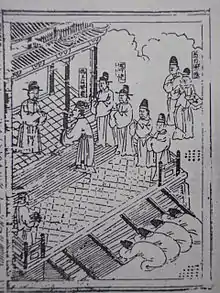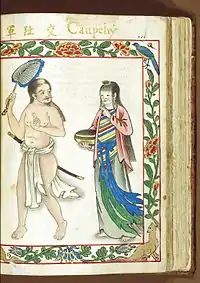Lê–Mạc War
| Lê–Mạc War | |||||||
|---|---|---|---|---|---|---|---|
.jpg.webp) A painting of Revival Lê dynasty | |||||||
| |||||||
| Belligerents | |||||||
|
Mạc dynasty Bầu Lords (from 1594) Ming dynasty (politically) |
Revival Lê dynasty Bầu Lords (1527-1593) Nguyễn Lords Trịnh Lords | ||||||
| Commanders and leaders | |||||||
|
Mạc Thái Tổ Mạc Thái Tông Mạc Kính Điển Nguyễn Kính Phạm Tử Nghi Dương Chấp Nhất Lê Bá Ly (until 1551) Nguyễn Quyện Mạc Đôn Nhượng Mạc Ngọc Liễn Lê Khắc Thận (to 1551, from 1572) Bùi Văn Khuê (to 1592, from 1600) Mạc Kính Chỉ Mạc Kính Cung Mạc Kính Khoan Mạc Kính Vũ |
Nguyễn Kim Trịnh Kiểm Trịnh Tùng Lại Thế Vinh Nguyễn Hoàng Lê Bá Ly (1551-1557) Hoàng Đình Ái Nguyễn Hữu Liêu Nguyễn Khải Khang (from 1551) Lê Khắc Thận (1551-1572) Vũ Sư Thước Lại Thế Khanh Bùi Văn Khuê (from 1592-1600) Trịnh Tạc Lê Thì Hiến Lê Sĩ Triệt Đinh Văn Tả | ||||||
| Strength | |||||||
| around 120,000 | around 60,000 | ||||||
| Casualties and losses | |||||||
| unknown | unknown | ||||||
The Lê–Mạc War (Vietnamese: Chiến tranh Lê-Mạc) was a long-time civil war waged between two Vietnamese dynasties, the Mạc and Revival Lê, during the Southern and Northern Dynasties period of Vietnamese history.
The Vietnamese throne was usurped by Mạc Đăng Dung in 1527. Lê Ninh, a prince of the Later Lê dynasty, escaped to Lan Xang. In 1533, Lê Ninh proclaimed himself emperor with the support of Nguyễn Kim and Trịnh Kiểm. The civil war between the two dynasties thus ensued.
In 1592, Thang Long, the capital of the Mạc dynasty, was reconquered by the Later Lê forces, marking the end of the Southern and Northern Dynasties period. Mạc rulers fled to Cao Bằng Province with the direct support of the Chinese Ming and Qing dynasties until 1677.
Background
Since 1428, Vietnam was united under the rule of the house of Lê (Later Lê dynasty) after the founder Lê Lợi, also the leader of Lam Sơn uprising, who drove out the Ming Chinese invaders. Soon after, the monarch adopted Neo-Confucianism and state-centralization as nation's idea. The fifth monarch, Emperor Lê Thánh Tông (Lê Hạo) had created the solid National Code based on Neo-Confucian beliefs, help flourishing businesses and trades, and successful expanded Vietnamese's territories into the Mekong delta and Xiangkhoang Plateau (formerly known as Trấn Ninh plateau).[1]:84
After Thánh Tông's death in 1497, Vietnam fell into swift decline. In 1515, Trần Cảo launched rebellion against the court.[1]:87 In 1517, a massive typhoon struck Thái Bình and Hải Dương provinces, killed 21,000 peasants. Agriculture and business began collapsing. Widespread angry peasants and workers demonstrated through in these provinces. 6 succeed monarchs after Lê Thánh Tông had lost control on the government and the army, caused the rise of military rulers and corruption.[1]:85 In 1522, a military general name Mạc Đăng Dung during his power struggle against the dominant Trịnh clan and Nguyễn clan, had gained the regent of the government by installing Prince Xuan as new Emperor.[1]:86:108 In 18 June 1527, Mạc Đăng Dung executed Lê Cung Hoàng and established the new Mạc dynasty. The deposed Lê royal family went exile in Lan Xang. In 1533, a Lê loyalist general Nguyễn Kim brought prince Lê Duy Ninh from Trấn Ninh as the emperor Nguyên Hòa, seek to overthrow Mạc Đăng Dung, and reestablished the Lê monarch in Xiangkhoang Plateau. With the help of Vietnamese migrants in Xiangkhouang, the Lê army regained Thanh Hóa and Nghệ An provinces, set Tây Kinh in Thanh Hóa as temporary capital and base for return the Lê monarch, and started the period Southern and Northern dynasties (Nam Bắc Triều) in Vietnam, which lasted to 1592.

In 1537, Nguyên Hòa sent delegations to Ming China, sought to Chinese military supports for his reclaim the reign in Vietnam. Jiajing Emperor of Ming dynasty responded by sent 125,000 soldiers to the border, threatening the Mạc regime in Hanoi.[1]:123 In the final word, Mạc Đăng Dung surrendered to Ming dynasty in Friendship Pass in 1541 as he accepted his regime and monarch would be under Chinese protection and ceded half of Quảng Ninh province to China (now is Fangcheng, Guangxi).[2][3] While being under political protection of Ming China, the Mạc dynasty rebuilt agricultural economy, opened business and factories, rebuilt a strong-120,000 soldiers army. The Mạc dynasty also tolerate religions and foreign trades, allowed Buddhism and Taoism revived, with Christianity was free to spread and worship. Portuguese merchants and missionaries, had been in Vietnam since 1524 brought Christianity and arquebus technical to Vietnam.[4] The Southern Lê regime also opened for Westerners trade ports in Đà Nẵng and Hội An cities, quickly adopted matchlock technique to the army, but less tolerated for the new faith brought by missionaries. The Lê monarchs were under control of military regents from powerful Trịnh and Nguyễn families. Two monarchs both claimed their rightfully rules over Dai Viet, so they must to have the final defeat the enemy to unify Vietnam.
Conflicts
Conflicts in 1554–1555
In 1554, Trịnh Kiểm, the military regent of Lê dynasty dispatched 25,000 men to the south and easily regained two provinces Thuận Hóa and Quảng Nam from the Mạc. Trịnh Kiểm also restored Cham principalities in Ninh Thuận and Bình Thuận.
In August 1555, Prince Mạc Kính Điển of Northern dynasty, led 100 warships attacked on Thanh Hóa shores. When Mạc fleet was advancing on Mã River, Lê forces under Trịnh Kiểm ambushed them by matchlock firearms and canoes led by general Nguyễn Khải Khang, a Mạc defector. Mạc Kính Điển survived and fled back to Hanoi.
Conflicts in 1557
July 1557, Mạc Kính Điển launched another naval offensive to the south. Lê warships one again ambushed Mạc fleet on Mã river. Mạc Kính Điểm jumped down the river and fled to the nearby forest. He and Mạc remnants escaped back to the north after three days hid in a cave. With the winning triumph, Lê army pursued Mạc army to Sơn Nam (Nam Định province). Mạc Kính Điển returned to his position and defeated the Southern army.
Conflicts in 1559–1562

September 1559, Trịnh Kiểm ordered new northward offensive, dispatched 60,000 soldiers and elephants, armed with Portuguese-style matchlocks. By January 1560, Lê-Trịnh army had occupied all cities and territories beyond south of the Red River, leave Mạc capital Đông Kinh under siege. Mạc emperor Quang Bảo evacuated his government to Quảng Ninh province, near China while reinforcing 50,000 men to defend Hanoi and Hải Dương. After fighting for a year, Lê-Trịnh army still unable to capture Hanoi and Hải Dương. In March 1561, Mạc Kính Điển launched a surprise naval attack in Thanh Hóa and Nghệ An, forced the Lê-Trịnh army to retreated back to Thanh Hóa to avoid Mạc's encirclement. Finally, two sides had been very tired, and withdrew their forces back to original territories.
Conflicts in 1570–1579

In 1570, Trịnh Kiểm died and his son Trịnh Cối succeed the military ruler of the Southern army. Take advantage, in August 1570 Mạc Kính Điển launched a large southward offensive, dispatched 100,000 men and 700 ships, attacked the Southern court through Laos and sea. Trịnh Cối surrendered to the Mạc. Southern Emperor Lê Chính Trị transferred the Military Commander to Trịnh Tùng while evacuating his government to the south. Mạc army while occupying and looting Tây Kinh, committed atrocities against civilians and architectures. In 1571, Mạc forces advanced further south to Cả River. In October 1572, Mạc forces retreated back to north.
From 1573 to 1576, Northern dynasty had launched 4 southward offensives and raids, caused devastation for the Southern dynasty. The Lê-Trịnh army then recruited Cham people into army to fight against the Mạc.
In September 1577, Mạc Kính Điển saw the opportunity to annihilate Southern dynasty, reunify the country. Mạc Kính Điển and his general Lại Thế Mỹ led 40,000 men attacked the Southern court in Thanh Hóa, but were defeated by Lê-Trịnh forces in Khoái Lạc. Thế Mỹ was shot and killed while mounted on horseback.
From August 1578 to November 1579, Northern Mạc forces made more three raids into Southern dynasty territories, but all were repelled with outgunned Lê-Trịnh matchlocks.
Conflicts in 1580–1583

From 1580 to 1583, Lê-Trịnh and Mạc forces engaged small to moderate-size conflicts along the Mã River. In November 1580, Mạc Kính Điển died and his brother, prince Mạc Đôn Nhượng succeed the military ruler of northern dynasty. The Mạc regime began declining and these were the last Northern dynasty's southward offensive.
Conflicts in 1584–1589
In 1584, new Northern emperor Mạc Mậu Hợp succeed the throne when he was child, the monarch and government were more unstable. Military lord Trịnh Tùng commands the Southern army, launched five raids into Northern dynasty's territories, caused severe damaging on economy and weakening the Mạc regime. Trịnh Tùng also hired the Wokou pirates as mercenaries, raiding the coastal area and port cities in Northern territories.
The last stand of Northern dynasty (1592–1593)
In February 1592, the Southern dynasty launched a large northward offensive against the Northern Mạc. Trịnh Tùng and his general Nguyễn Hữu Liêu, Trịnh Ninh, Hoàng Đình Ái, Trịnh Đồng, Trịnh Đỗ, Hà Thọ Lộc and Ngô Cảnh Hựu commanded 60,000 troops, captured towns and cities beyond south of the Red river. Mạc Mậu Hợp sent all his troops to resist the Southern army, but was defeated.
In 14 November 1592, Lê-Trịnh army captured three western province Lào Cai, Yên Bái and Phú Thọ. In 25 November, Trịnh Tùng's forces arrived Hải Dương, arrested and executed Mạc Mậu Hợp and his son Mạc Toàn. The Mạc remnants fled to mountainous Bắc Cạn, Cao Bằng provinces, and still in active. In April 1593, the southern emperor Lê Thế Tông was welcomed back to Đông Kinh (Hanoi).
Aftermath

The Lê monarch, after 59 years war with rival Mạc, returned back to the throne of Đại Việt. However, the Ming dynasty of China still only recognized the Mạc regime in Cao Bằng as rightfully ruler of Dai Viet. In 1597 Lê Thế Tông sent emissary Phùng Khắc Khoan to Beijing for renewing relation with China, who supports the Mạc dynasty.[1]:165 At the result, the Ming China recognized both Lê and Mạc were legitimacy rulers of Vietnam, and in 1644 they officially re-recognized the Lê monarch as "king of sovereign Vietnam".[1]:178
The remnant Mạc monarch in Cao Bằng province, recruited Tai-speaking mountain tribes into their army. They also brought the Vietnamese Nôm script adoption to Tày people, called the Nôm Tày script.[5] Mạc regime and the Vũ Văn clan's "chúa Bầu" in Hà Giang province, still were threatens of the Lê-Trịnh regime until they were annexed and went exiled to China in 1677.
The Trịnh military lords who regents the Lê Dynasty, who's capital in Đông Kinh (Tonkin or Hanoi), soon find disloyal of the Nguyễn governor in central and southern Vietnam. Over next 30 years of unification and the temporary peace, Vietnam one again would be divided by two military lords for another 150 years–fought against each other in the indecisive Trịnh–Nguyễn War. These long civil wars had devastated the Vietnamese nation both its structure and economy, causing the great dissatisfaction among the ordinary class and working class to the monarchs and the aristocrats, which ultimate lead to the final boom - the Tây Sơn rebellion in late 18th century. The Chu Đậu ceramic factory in Chu Đậu village, Hải Dương province who famously exporting Vietnamese blue-white ceramics to Japan and West Asia from 13th to 17th century was destroyed.
References
- Kathlene Baldanza (2016). Ming China and Vietnam. Cambridge University Press. ISBN 9781107124240.
- John W. Dardess (2012). Ming China, 1368-1644: A Concise History of a Resilient Empire. Rowman & Littlefield. pp. 5–. ISBN 978-1-4422-0490-4.
- http://www.eacrh.net/ojs/index.php/crossroads/article/view/43/Vol8_Yamazaki_html
- Encounter and cultural influences of the Portuguese and French in Vietnamese history from XVI to XIX century, University of Huế
- Bảo tồn chữ Nôm của dân tộc Tày tỉnh Bắc Kạn
Citations
- Kathlene Baldanza (2016). Ming China and Vietnam. Pennsylvania: Cambridge University Press. ISBN 9781107124240.
- John W. Dardess (2012). Ming China, 1368-1644: A Concise History of a Resilient Empire. Rowman & Littlefield. pp. 5–. ISBN 978-1-4422-0490-4.
- Tran Trong Kim (2005). Việt Nam sử lược (A Brief History of Vietnam) (in Vietnamese). Ho Chi Minh City: Ho Chi Minh City General Publishing House. pp. 260–273.
- Chapuis, Oscar (1995). A History of Vietnam: From Hong Bang to Tu Duc. Greenwood Publishing Group. pp. 113–119. ISBN 0-313-29622-7.
- Taylor, K. W. (2013). A History of the Vietnamese. Cambridge University Press. ISBN 978-0521875868.